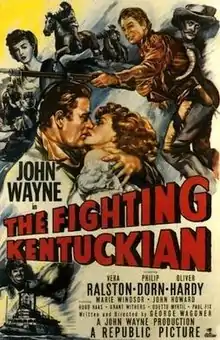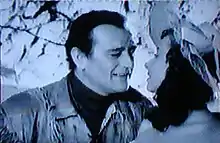The Fighting Kentuckian
The Fighting Kentuckian is a 1949 American Adventure Western film written and directed by George Waggner, It stars John Wayne who also produced the film, Vera Ralston, Philip Dorn, Oliver Hardy, Marie Windsor, John Howard, Hugo Haas, Grant Withers and Odette Myrtil.
| The Fighting Kentuckian | |
|---|---|
 Original cinema poster | |
| Directed by | George Waggner |
| Produced by | John Wayne |
| Written by | George Waggner |
| Starring | John Wayne Vera Ralston Philip Dorn Oliver Hardy Marie Windsor John Howard Hugo Haas Grant Withers Odette Myrtil |
| Music by | George Antheil |
| Cinematography | Lee Garmes |
| Edited by | Richard L. Van Enger |
Production company | John Wayne Productions |
| Distributed by | Republic Pictures |
Release date |
|
Running time | 100 minutes |
| Country | United States |
| Language | English |
| Box office | $1,550,000[1] |

Plot
Returning home from the War of 1812, John Breen, a Kentucky militiaman, falls in love with French exile Fleurette de Marchand (Vera Ralston). He discovers a plot to steal the land that Fleurette's exiles plan to settle on. Breen is mistaken for a land surveyor and is presented with a theodolite and sets out with Willie (Oliver Hardy) to look as if they are surveying (they do not actually know what to do).
A further pretence occurs when Breen sits on stage with a group of fiddlers and feigns being able to play.
Throughout the film, Breen's soldiers sing:
- Only six hundred miles more to go
- Only six hundred miles more to go
- And if we can just get lucky
- We will end up in Kentucky
- Only six hundred miles more to go
When the song is first heard, there are eight hundred miles to go (the tune is She'll Be Coming Round the Mountain).
Historical setting
The story is set in Alabama in 1818, including the city of Demopolis, which was founded by Bonapartists. The Bonapartists had been exiled from France after the defeat of Napoleon I at the Battle of Waterloo. Congress authorized the sale of four townships in the Alabama Territory in March 1817 at two dollars per acre, and Marengo County was created on February 7, 1818 from lands that had been taken from the Choctaw Nation under the Treaty of Fort St. Stephens. It was named after Spinetta Marengo, Italy where Napoleon defeated Austria in 1800 in the Battle of Marengo. The county seat, Linden, Alabama, was named after Hohenlinden, Bavaria where Napoleon won another victory against the Austrians. The Bonapartist colony did not succeed overall, in part due to surveyance issues that contribute to the plot of the film and in part due to practical difficulties in establishing the vineyards.[2][3][4]
Cast
- John Wayne as John Breen
- Vera Ralston as Fleurette de Marchand
- Philip Dorn as Col. Georges Géraud
- Oliver Hardy as Willie Paine
- Marie Windsor as Ann Logan
- John Howard as Blake Randolph
- Hugo Haas as Gen. Paul de Marchand
- Grant Withers as George Hayden
- Odette Myrtil as Madame de Marchand
- Paul Fix as Beau Merritt
- Mae Marsh as Sister Hattie
- Jack Pennick as Capt. Dan Carroll
- Mickey Simpson as Jacques (wrestler/Marie's father)
- Fred Graham as Carter Ward
- Mabelle Koenig as Marie
- Hank Worden as Abner Todd (uncredited)
- Fred Aldrich as Militiaman (uncredited)
- Richard Alexander as Militiaman (uncredited)
- Hank Bell as Militiaman at Festival (uncredited)
Production notes
This is one of only five times that Hardy worked without partner Stan Laurel after they'd teamed up as Laurel and Hardy. Hardy also appeared with Harry Langdon in Zenobia (1939), and in three cameos: Riding High, Barnum & Ringling, Inc. and Choo-Choo! It was the only time that Hardy appeared in a film with John Wayne, though the two had worked together onstage a year earlier in a touring charity production of What Price Glory? starring Wayne, Ward Bond, and Maureen O'Hara, and directed by John Ford.[5] Re-broadcast by Arte 1 February 2017, the film credits celebrated composer Georges Antheil (1900-1959) with the music (background score including among things stirring "variations" on the Marseillaise).
The film was the second one produced by John Wayne for Republic Pictures. It was stuntman Chuck Roberson's first work with John Wayne with Roberson doubling Wayne throughout his career.[6] Wayne desired a French actress for the lead role and considered Danielle Darrieux, Simone Simon and Corinne Calvet but was forced to use Republic Studio's Vera Ralston causing other Czech and Austrian actors to be cast to match Ralston's accent.[7][8]
References
- "Top Grossers of 1949". Variety. 4 January 1950. p. 59.
- Bonapartist refugees in Americas 1815-50
- Encyclopedia of Alabama Marengo County
- Latitude 34 North: Marengo County (46) Historic Markers Across Alabama
- McCabe, John (writer). Babe: The Life of Oliver Hardy. Citadel, 1990.
- pp. 103-104 Landesman, Fred The John Wayne Filmography McFarland, 13 Aug 2015
- p.192 Eyman, Scott John Wayne: The Life and Legend Simon and Schuster, 21 Apr 2015
- Farkis, John Not Thinkin'... Just Rememberin'... The Making of John Wayne's "The Alamo" BearManor Media, 25 Mar 2015
| Wikimedia Commons has media related to The Fighting Kentuckian. |